Rule #1: You cannot stop a determined thief
Rule #2: If you think you can stop a determined thief, see Rule #1

What you can do is make stealing your property more time consuming and difficult, resulting in the potential criminal moving on to easier pickings. This is what I have done and will share in this post. Prior to this my efforts have just been to “keep the honest people honest.”
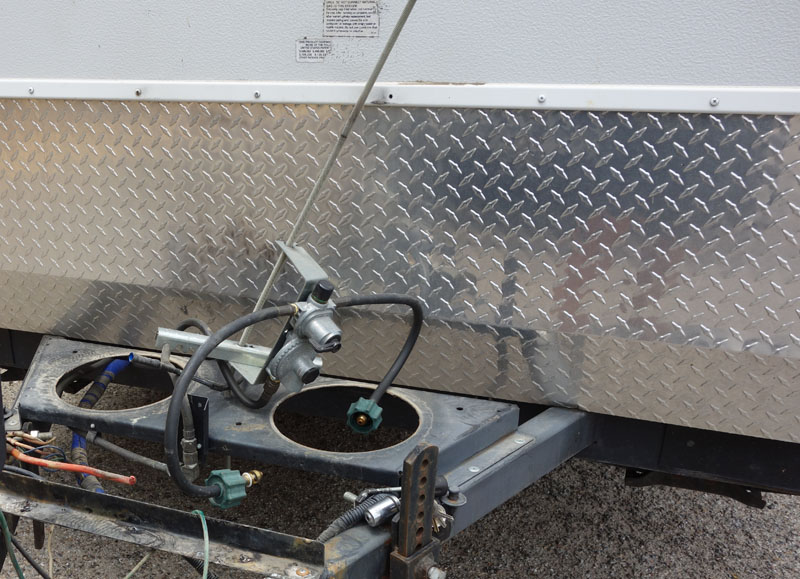
Is a Secure Location the Answer?
In my last post I shared the lack of security at our storage facility. Obviously, a secure location should be a primary concern, however a secure facility does not guarantee true security. We have now located a better facility for our travel trailer, which I will share in a future post.
I am more concerned about theft when our travel trailer is not being stored. We camp in remote locations. It is common for us to be away from our campsite all day. Even though we are “senior citizens,” we do all-day hikes, leaving our remote campsite vacant. We know we can’t secure everything, but we do minimize what can be quickly be the target of a grab-and-run criminal.
What thieves are Looking to Steal from Your RV
Talking to many people, there are three things that are most commonly stolen from RVs these days: catalytic converters from gasoline powered motor homes, batteries, and propane tanks.
I have found that propane tanks, like vehicle catalytic converters, have become prime targets for these scumbags, and folks in our city report thefts of their patio BBQ propane tanks with greater frequency. It has been reported in media that the allure of propane tank theft is the tanks are used in the manufacture of illegal methamphetamine. Here is a news article explaining how the tanks are used.
Earlier this year I replaced the heavy lead-acid deep cycle batteries with a more expensive and lighter LiFePo4 battery. Unlike the old batteries that were stored on the trailer tongue in a locked battery box, the new battery is now stored in the interior storage compartment of our trailer, which is probably less secure. New measures to better secure this battery are needed. I will share what I have done in the near future.
While these three items maybe at the top of the criminal’s “shopping list,” anything that can be easily and quickly taken is subject to loss.
A Brief History of Our Experiences as Victims of these Crimes
We live in a fairly affluent city. Our street is only one block long with ingress and egress at each end of the street. Few people drive by our house unless they need to be on our particular street, plus residents are alert to any potential thief. This isn’t a deterrent.
Years ago, l preparing for an early morning departure, we had placed our bikes on our tent trailer’s bike rack and “secured” them with a top-of-the line Yakima bike rack “jaw clamp” frame lock. The next morning the bikes were gone. The only consolation was they were inexpensive bikes.
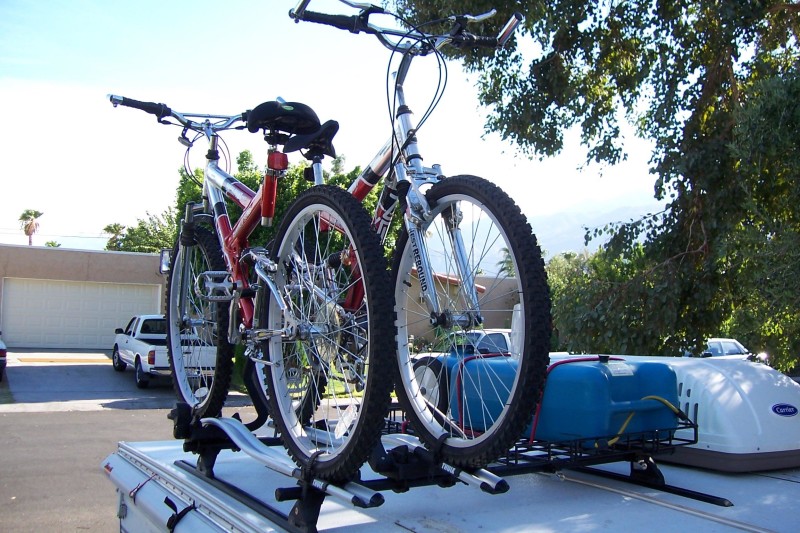
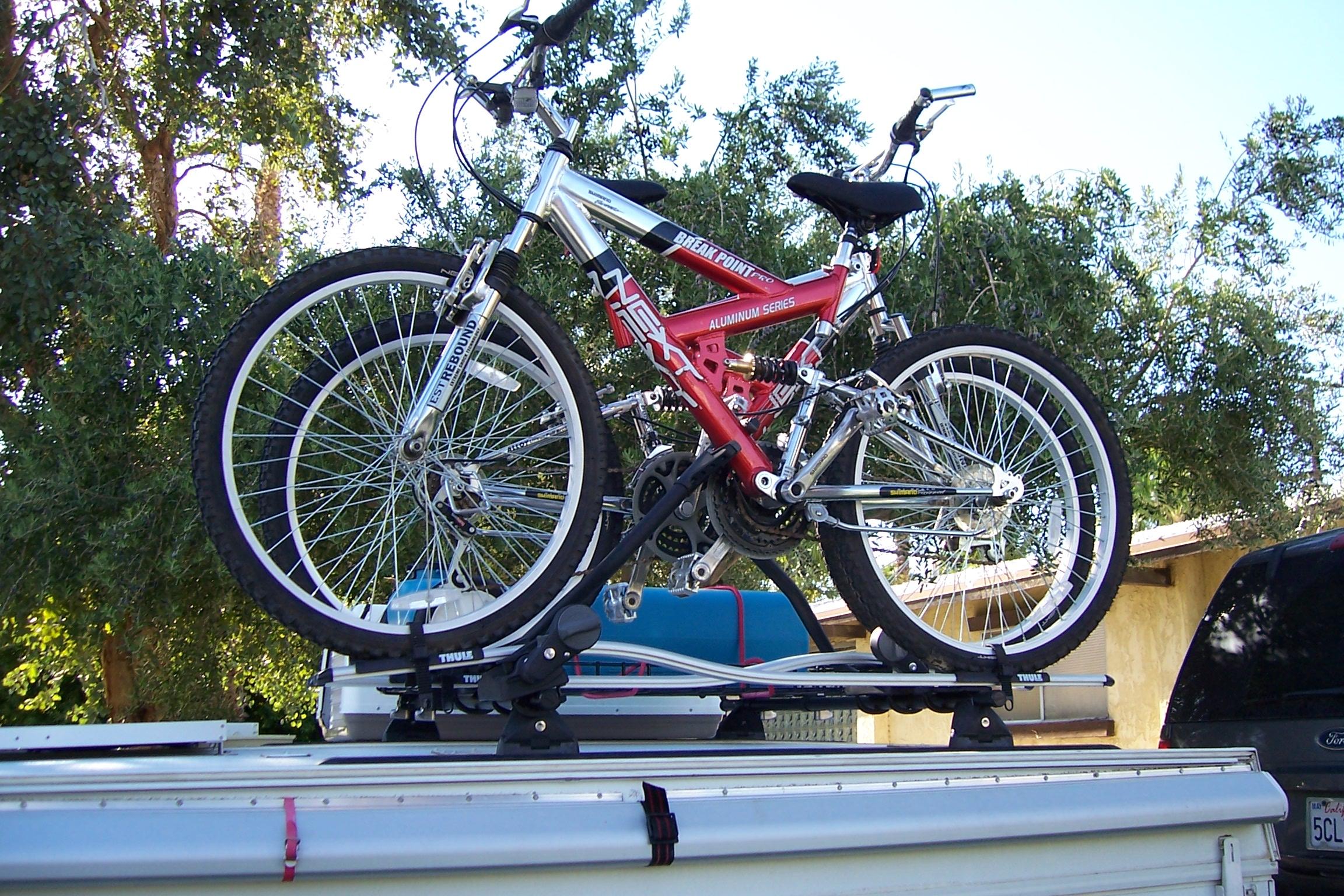
Another crime was the theft of one of the tire and wheels on our 2012 Ford Expedition a few years back. We only lost one wheel, but I found that the lug nuts had been loosened on the other rear wheel, so the thieves must have been interrupted.
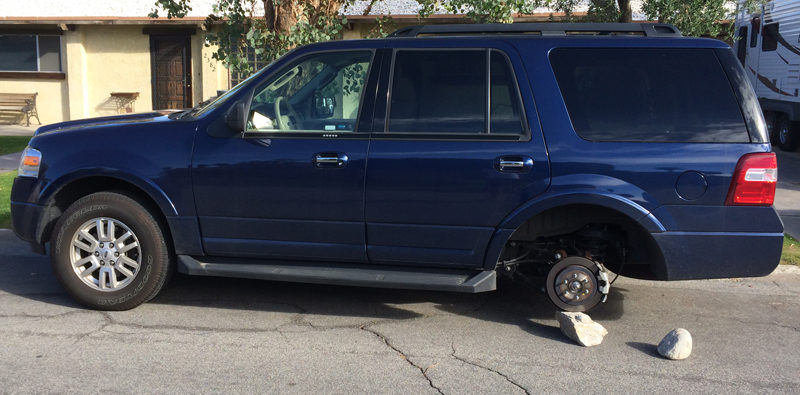
A couple years ago someone broke into our 1999 Ford Mustang and stole a Garmin GPS unit, which was out of sight at the bottom of the center console. They also broke into the glove box and stole the package that contains the Owner’s Manual, Car Registration, and Insurance Card. A neighbor three blocks away found the package in the street in front of her house and returned it to us.
And then there was the vandalism of our 2006 Fleetwood Niagara, that resulted in our insurance company declaring it a total loss. In this case, much was stolen and damaged and the animals just used brute force like a gorilla.
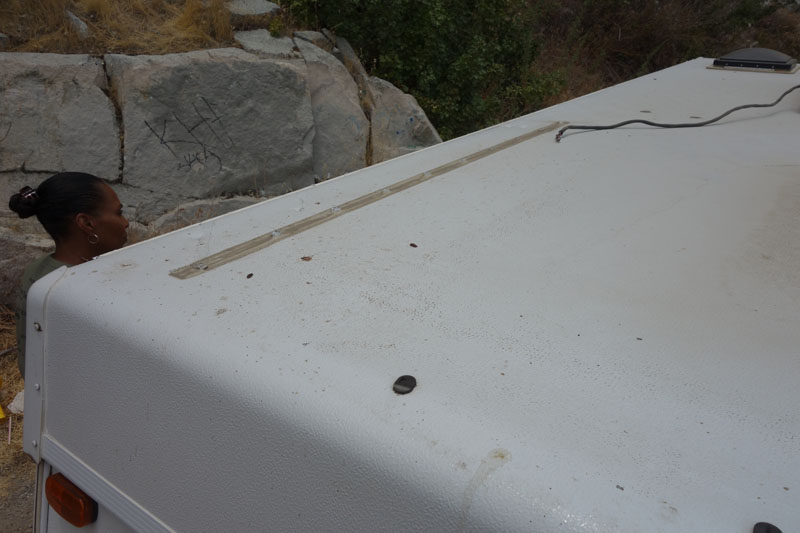
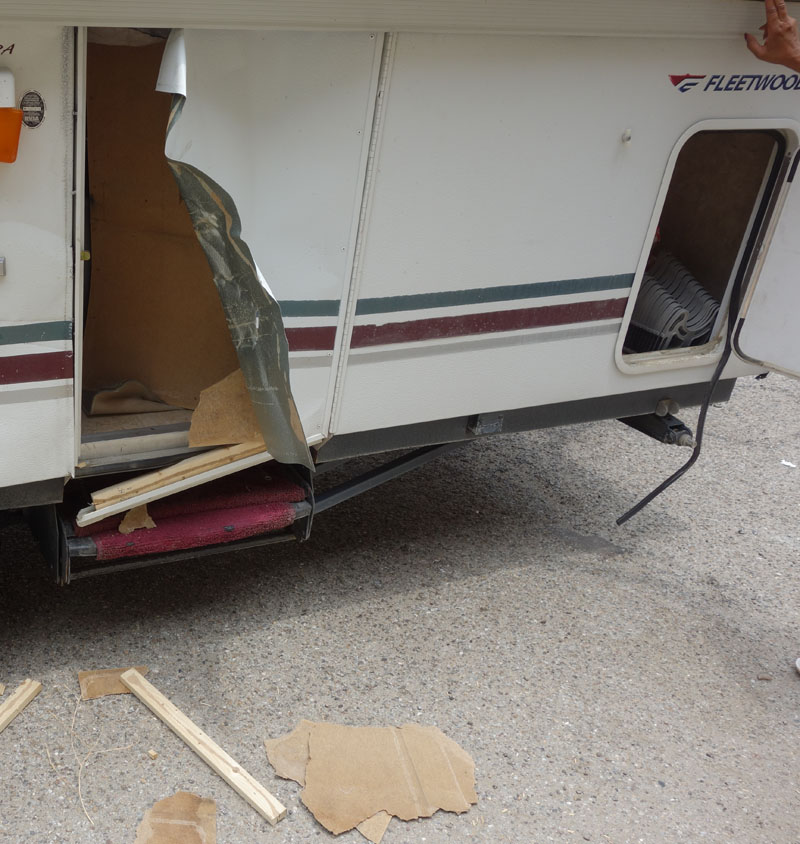
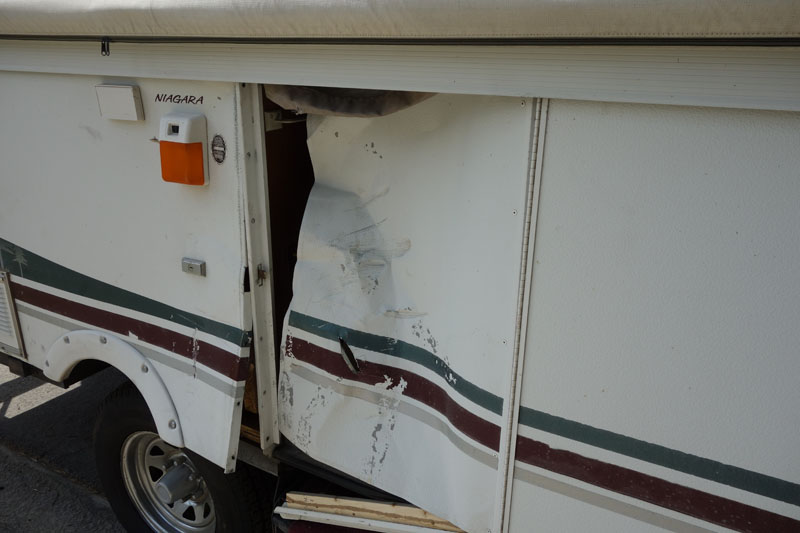
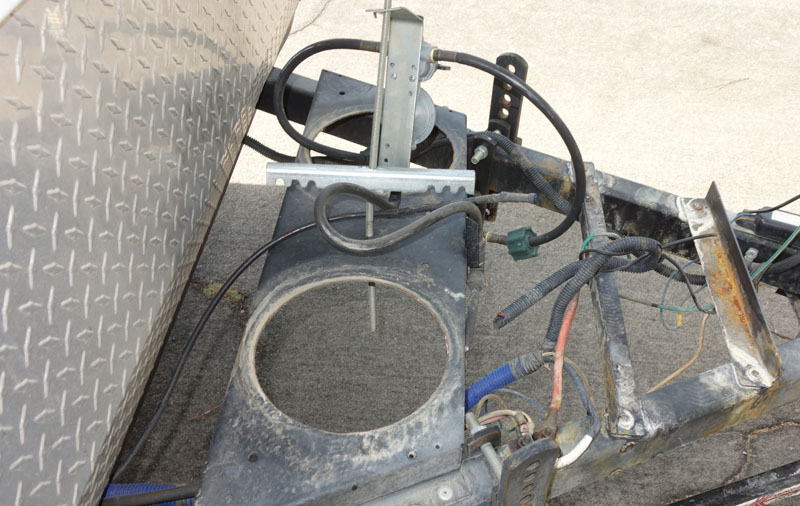
How Much Money Should One Spend on Securing Property?
The loss of our propane tanks was nominal in the big picture of life. Our lives weren’t in jeopardy, which is the most important thing.
Our old propane tanks were 9 years old. Once a propane tank reaches 12 years in age, they must be replaced or re-certified. Propane suppliers will not fill an expired tank. Where we live, there isn’t anyone who re-certifies portable propane tanks nearby. From what I have researched, re-certifying a tank is about just as expensive as buying a new one.
Replacing our 30 lb. tanks, which only had 25% of their useful life left, cost $99.95 each plus tax, the best price I found was the Flame King brand on Amazon. It cost a little over $68 to fill them.
This website may be compensated for linking to other sites for sales of products. As an Amazon Associate I earn a small fee from qualifying purchases at no additional cost to the purchaser.
The TorkLift Propane Tank lock that I had installed in 2015, which didn’t stop the theft, is now a $95 item.
The total replacement cost would be around $400, if I were to buy a new TorkLift lock along with two new tanks and fill them with propane.
If I were to spend an additional $400 to better secure our tanks, total investment would be $800. If I were to do little to improve security, another propane tank theft would be $400 and I would be starting all over. So I set an initial budget of $800, but kept an open mind to improved security and potentially more cost.
Other Considerations
I have not factored in the cost of time and inconvenience to replace the stolen items.
Another point to consider is that if our propane tanks are stolen from a remote campsite, our trip might be over. It is not unusual for us to camp 50 to 100 miles from the nearest town, and those itty bitty towns are, more than likely, not going to have the items we need. If they do, prices will probably much higher than what one can purchase in a large city or online.
Theft Post Mortem
I could not find the TorkLift Lock assembly at the theft site. It was gone. Also, I did not find any physical damage to anything left behind. So I couldn’t determine exactly how the tanks were stolen. Was it brute force, bolt cutters, or even a metal angle grinder? I don’t know.
I did see a potential weakness in the method of locking the hold-down bracket on the standard threaded rod found on most dual propane tank hold-down set-ups. There are many YouTube videos on various solutions.
Hold-down bracket weakness
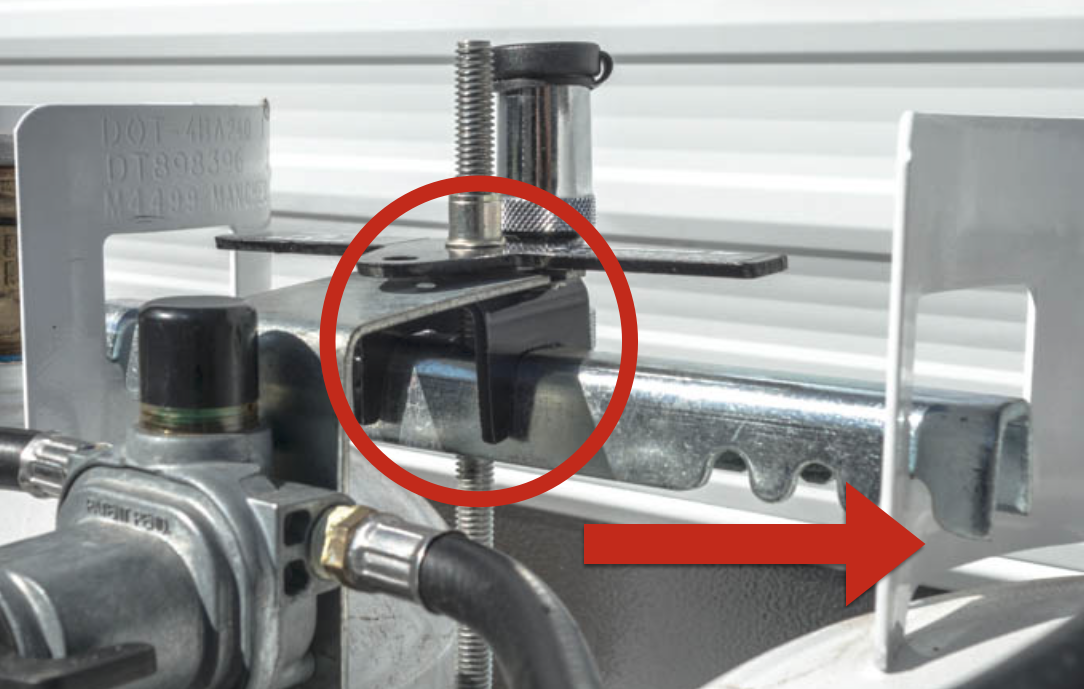
In the picture above, the red circle shows the TorkLift lock. The lock keeps the “wing nut” from being loosened unless the lock is removed. One issue is the TorkLock bracket (black) doesn’t cover much of the bracket that extends to the propane tank.
The red arrow points to where the bracket holds the propane tank down. If a thief wiggles the tanks and at the same time uses a pry bar, the bracket can be lifted up and by tilting the tank, the tank can be removed. Once one tank is removed, the other can easily be removed. I know, I tried it when I got our new propane tanks.
Also, in the picture above, the notch securing the tank is the one on the very end of the tank. I had placed it there because it is easier to remove the tanks for refilling. One could cut the notches deeper, so the bracket would have to be pried higher, but increasing the depth of the notch would weaken the metal making it fairly easy to bend.
This would be one weak area that needed to be addressed.
Optional and important findings
I found the main propane hose at the regulator that supplies gas to the trailer was kinked and damaged. This really was a matter of a nine year old hose that was at the end of its life.
Lastly, the Marshall Excelsior MEGR-253 Automatic Changeover Regulator was almost twenty years old. I like this regulator. I installed it on our 1992 Starcraft Meteorite in 2003 and transferred it to our 2006 Fleetwood Niagara. When the Niagara was destroyed by thieves, they left the regulator behind and I transferred it to our 2014 Eclipse Milan.
The regulator was still good — I tested the pressure with a manometer.
A manometer is a good tool to have if you own an RV. Many, many propane regulators are replaced when the owner thinks it might be bad, but do not have a method of testing the regulator, which should have 11 inches water column of pressure.
Most manufacturer’s recommend replacement after 10 years. Given our extreme weather environment, I decided to replace the regular and connecting hoses.
Anti-Theft Strategies
The more obstacles one can place in front of the criminal, the more steps he or she will need to overcome to steal your stuff. If it requires too many steps, the scumbag will just move on to easier pickings.
A thief will, more than likely, have one or more tools.
Pry bars are cheap and easy to carry, but not very effective.
Bolt cutters are a step up. A 24” bolt cutter can easily cut through 3/8 inch shackles. 1/2 lock shackles require a bigger bolt cutter and a lot more muscle, especially if a padlock or chain is made from hardened steel or other security material. For 9/16 inch material, industrial strength (read big and heavy) cutters are required. Also, one wants to keep the security item (lock or chain) high enough off the ground, so that one arm of the bolt cutter cannot be placed on the ground for increased leverage.
Portable angle grinders will cut through most security solutions. At night they create a fireworks show with sparks everywhere. If the thief has to cut through really thick material the cutting disc may wear down and become ineffective. A portable angle grinder probably won’t cut through two or three 9/16” security pieces unless the cutting disc is replaced with a new one.
My strategy was to limit the potential thief to an angle grinder as the tool of destruction and force this scumbag to cut through several defenses.
Quality Matters
Top of the line security measures are not cheap. My choice, and there are others, is the German company ABUS. They rate their products on a scale of 10, with 10 being the most secure. Reviews of ABUS are often at the top of the heap.
My Security Measures: Phase 1
I started with the hold-down bracket, which is a simple threaded rod and a wing nut to keep the propane tanks secure — secure meaning they won’t fall of the trailer while driving.
Looking at the bracket, as previously identified as a weak point, I added a 3/16 inch thick piece of steel to reinforce the bracket. It is plain steel, so I painted it to prevent rust. See the red arrow below.
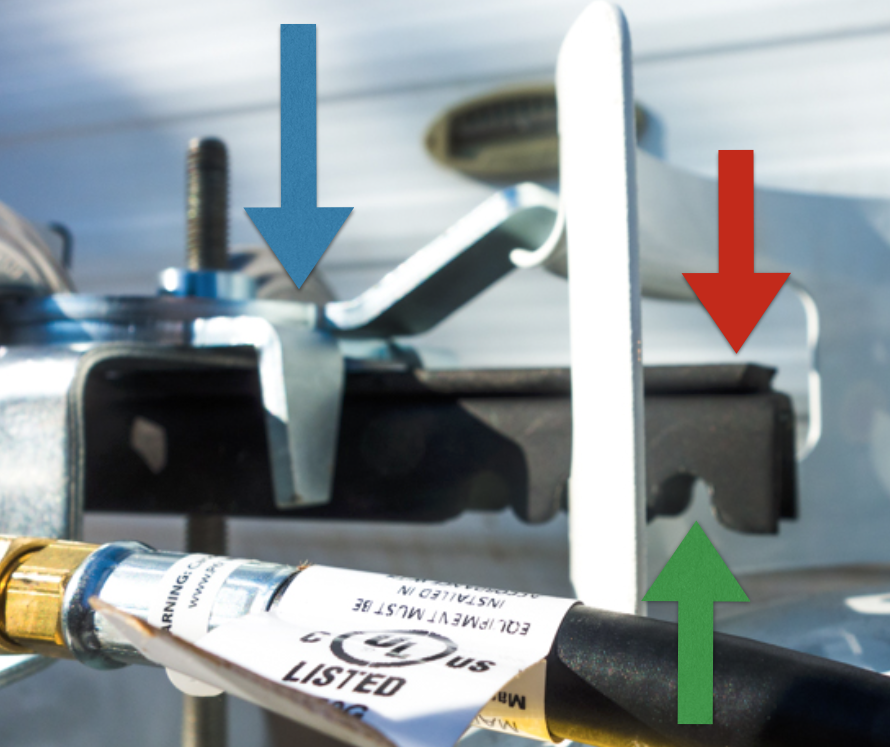
I also moved the tanks closer together. Looking at the green arrow above, you can see the last notch is no longer the hold-down point of the bracket.
The last step was NOT to use another TorkLift lock, but one made by CAMCO. The TorkLift is made from “military grade” aluminum (whatever that means). The Camco Double Propane Tank Locking Device is made from zinc plated steel, is wider so more of the bracket is covered by the CAMCO hardware (see blue arrow above), and I was able to install two locks on it, rather than a single lock with the TorkLift. Plus the CAMCO product is much cheaper!
The CAMCO unit comes with a cheap combination disc lock. That lock immediately went into the trash can and I used two ABUS 24/70 Diskus padlocks.
I have owned these ABUS padlocks before. Back in 1998 I rented an enclosed storage unit and the management required that an ABUS Diskus lock be used. ABUS rates this lock as an “8” which means it is a “medium” security item.
Below are images of the two ABUS Diskus locks installed on the CAMCO locking device.
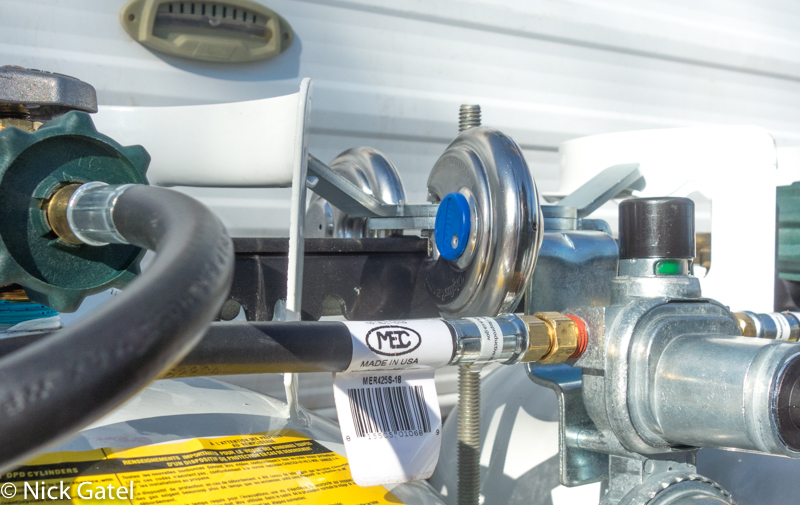
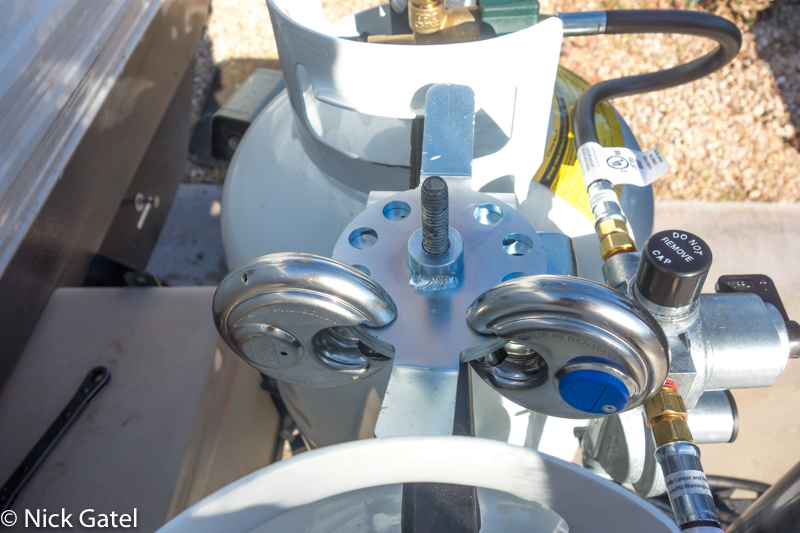
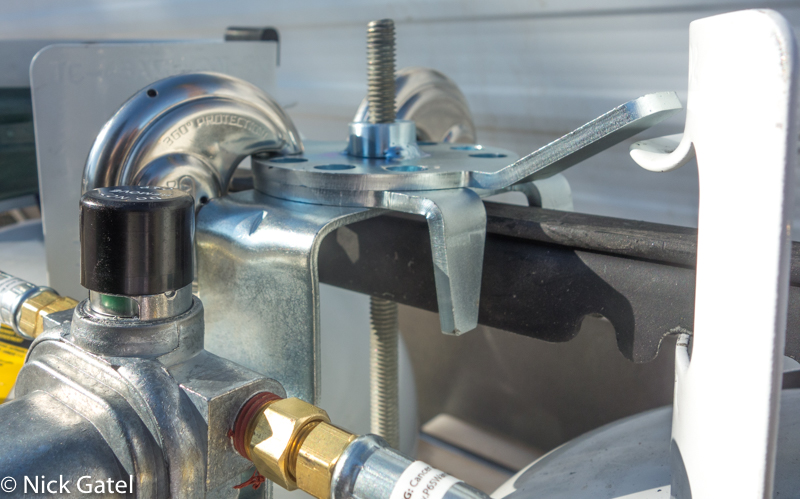
My Security Measures: Phase 2
Security Chain
You do not want a cable type of “chain” like the one below:
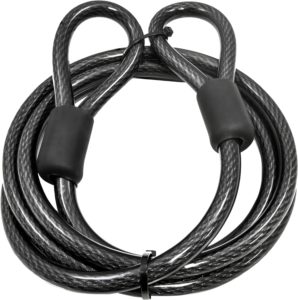
They are easy to cut through, even with inexpensive Diagonal Pliers. By snipping small groups of the strands in the cable a thief can cut it in half very quickly
The next, and final step for me, was to chain the tanks to the frame of the trailer. Ten feet was the minimum length for my application. I considered a 1/2” chain, but they were not available in this length and would have to be special ordered. So I opted for a 10 foot ABUS 14KS security chain. The links are 9/16 inch thick (14mm). The chain is heavy. 34 lb. heavy!!
I was able to loop the chain through two slots in each tank and then route it around the trailer’s frame.
My thinking was if someone wanted to cut the handle portion of the propane tank and slide the chain out, they would need to do more cutting. There are a lot of security measures very close to the propane tanks after I was finished.
When my wife looked at it she mentioned that if someone used an angle grinder to cut through everything, they might cause an explosion and destroy our camper. That’s fine, because we have insurance with a $500 deductible.
It would make my day if a criminal died trying to steal our property. Keep in mind that I haven’t “booby trapped” the security solution for the tanks. If a thief wants to risk their life to steal something, that is their decision and they will have to live (or die) with that decision.
Padlocks for the Security Chain
There are two good options for this chain.
ABUS 92/80 Monoblock
The least expensive is the ABUS 92/80 Monoblock with a 15/32 inch shackle.
It fits the 14KS chain perfectly. I already had one for another use. ABUS rates this a Level 8 Security Lock.
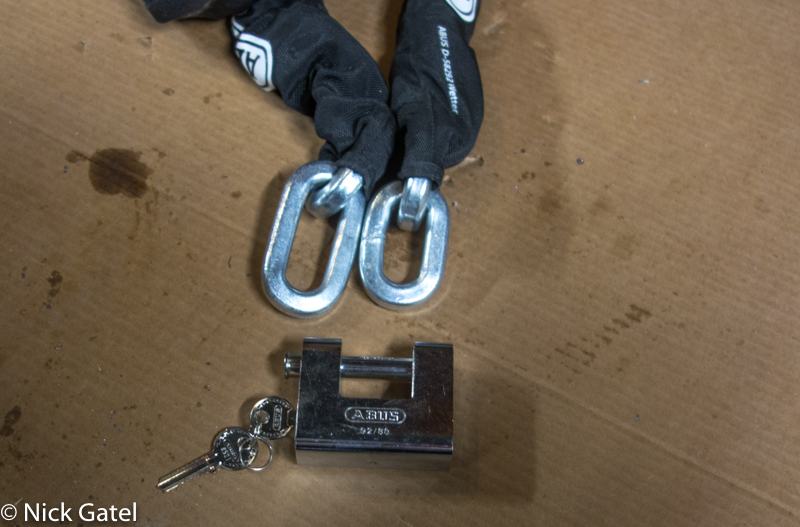
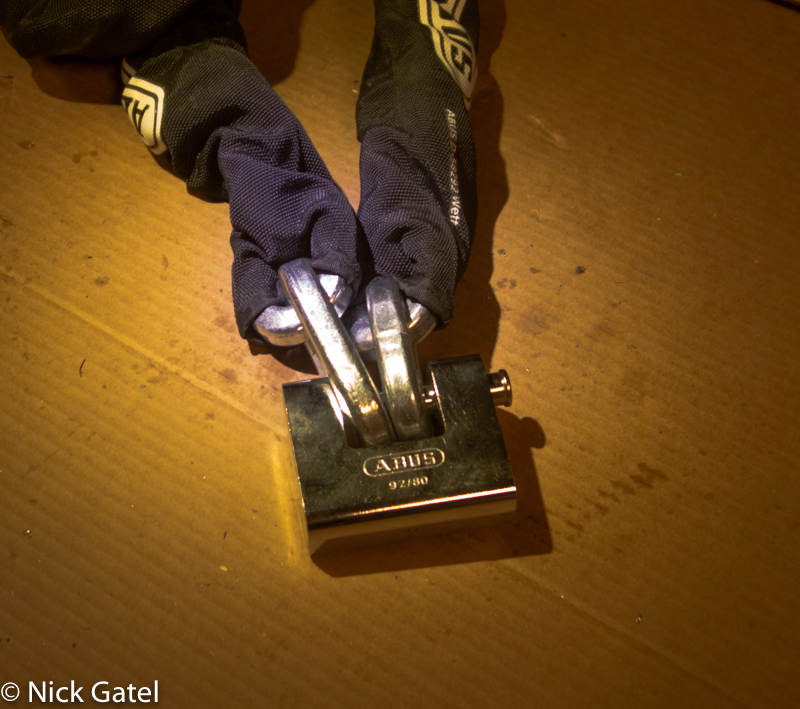
ABUS ABUS 37/80 Granit padlock
For the propane tank project I opted for an ABUS ABUS 37/80 Granit padlock. It is a Level 10 Security item with a 9/16” shackle.
By the way, don’t assume a Level 10 MasterLock is secure as an ABUS Level 10. It isn’t, which is why the MasterLocks cost less.
A nice touch with the ABUS chain is the links are not the same size, shape-wise. They alternate with the last links on each end able to nicely fit together.
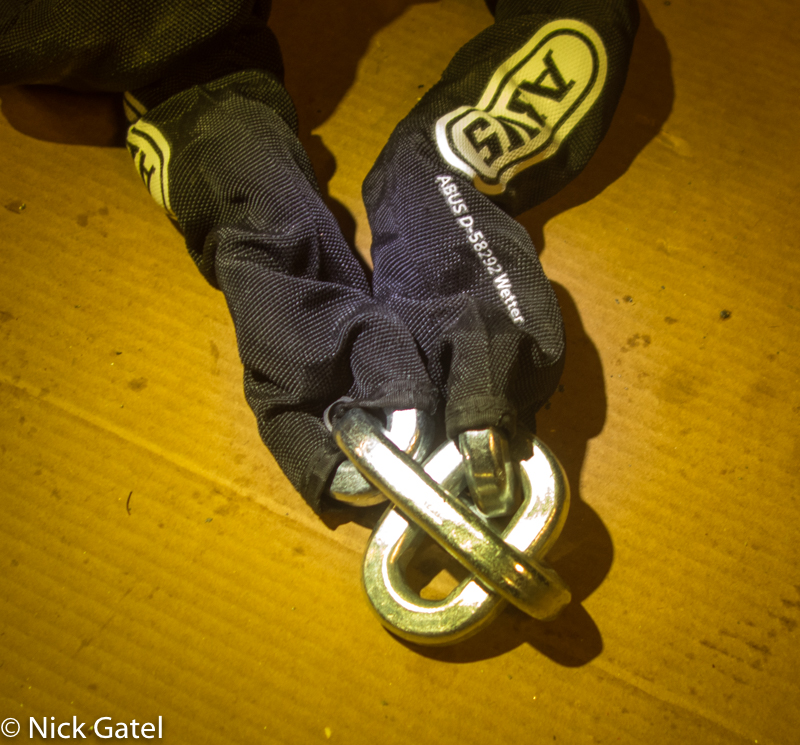
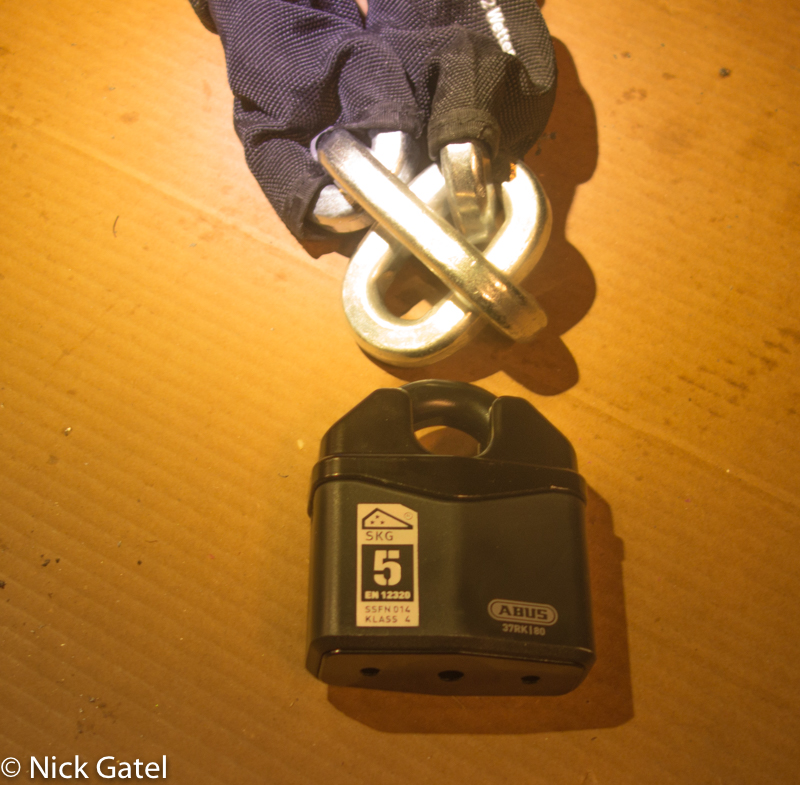
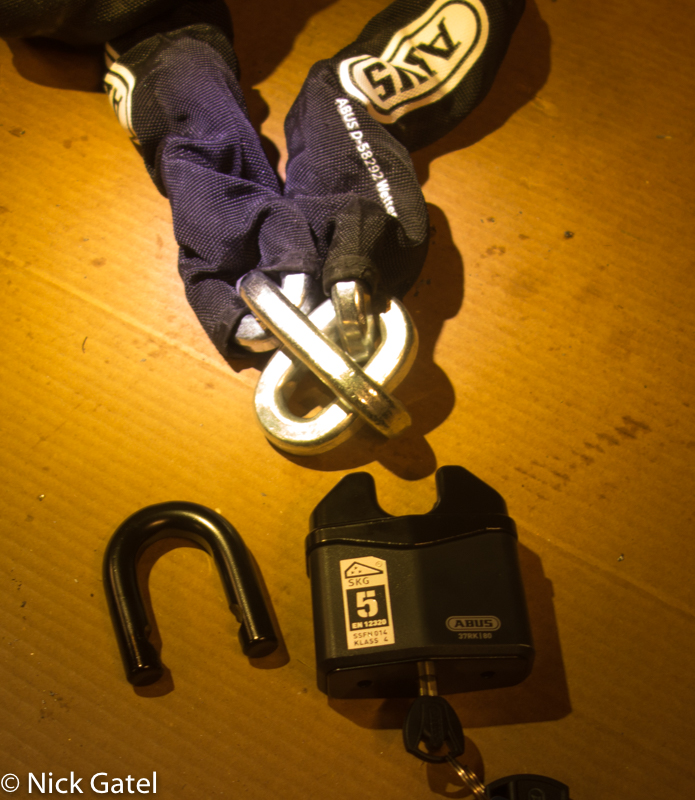
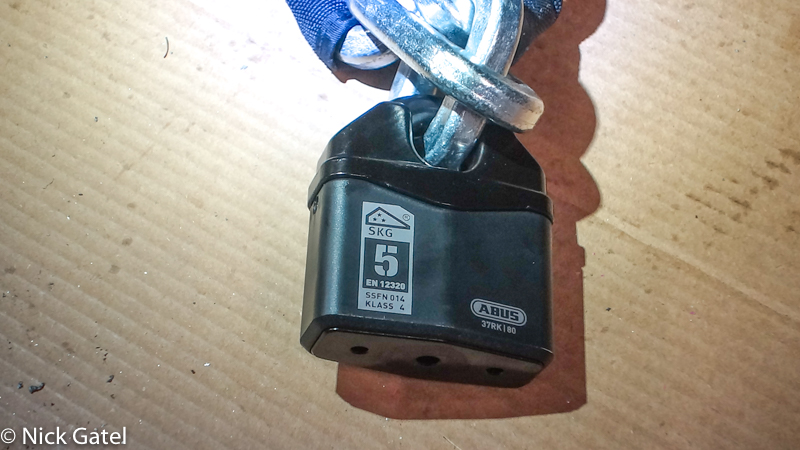
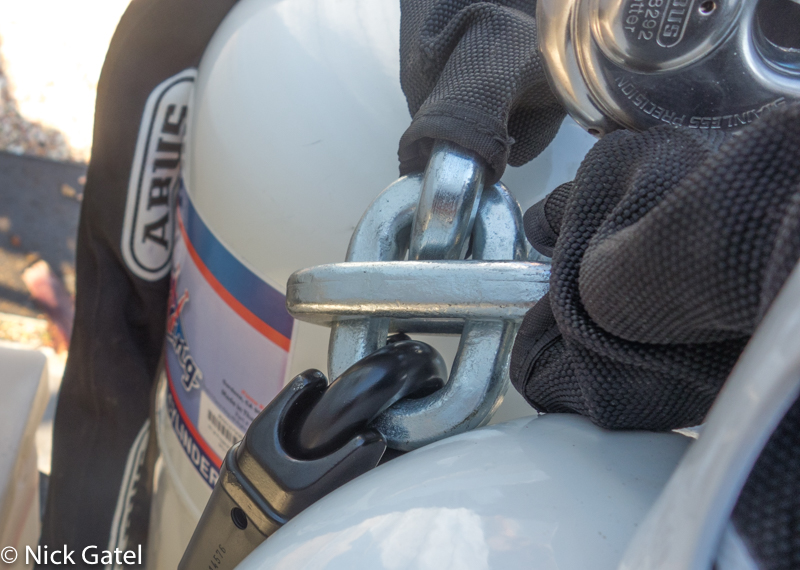
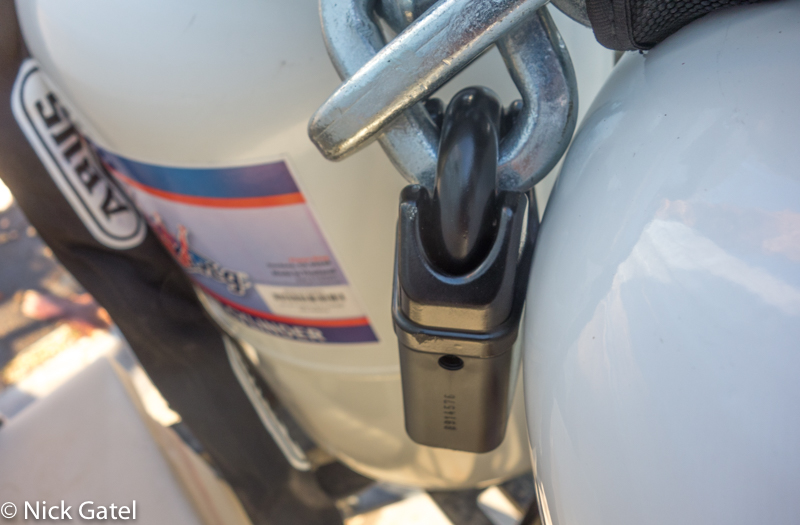
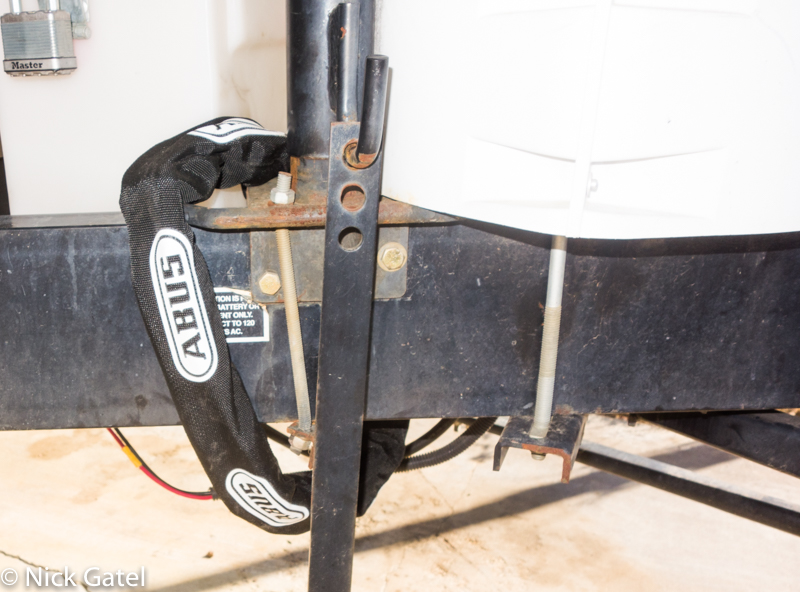
Cost
I ended up spending $800 plus tax for everything, right at my budget.
- Two 30 lb. propane tanks = $200 (dang they were on sale for $168 when I wrote this)
- Propane = $68
- CAMCO lock hardware = $44
- ABUS 14KS 10’ chain = $300
- Two ABUS Diskus padlocks = $60
- One ABUS Granit padlock = $127
- 3/16” steel plate I already had, but they are inexpensive, just a few bucks.
Finishing the Job
Marshall Excelsior MEGR-253P Two-Stage Propane Regulator
This was just to replace the almost 20 year old unit I already had and have been 100% happy with it.
I should mention that the regulator matches with 1/4 inch inverted male flare hoses, hoses you usually can’t buy at the local hardware store. To use the typical hose found in stores, you have to remove the inverted flares on the regulator, a difficult job because these fittings are practically glued to the regulator. You will have to place the regulator in a vise and use a long handle wrench, risking damage to the regulator.
Below are images of the fittings. No thread sealer needed with the flared fittings.
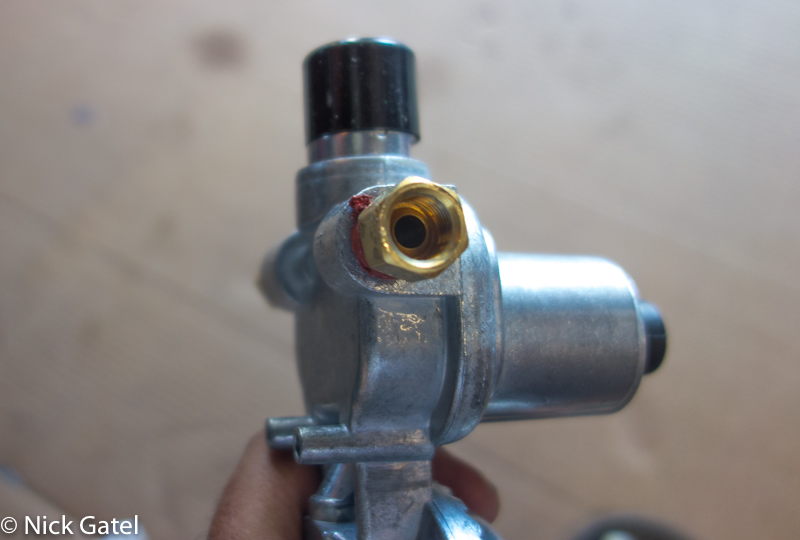
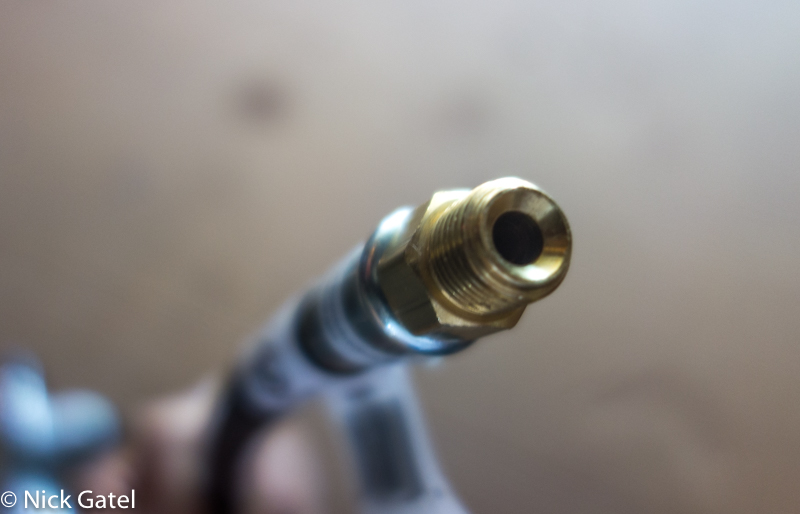
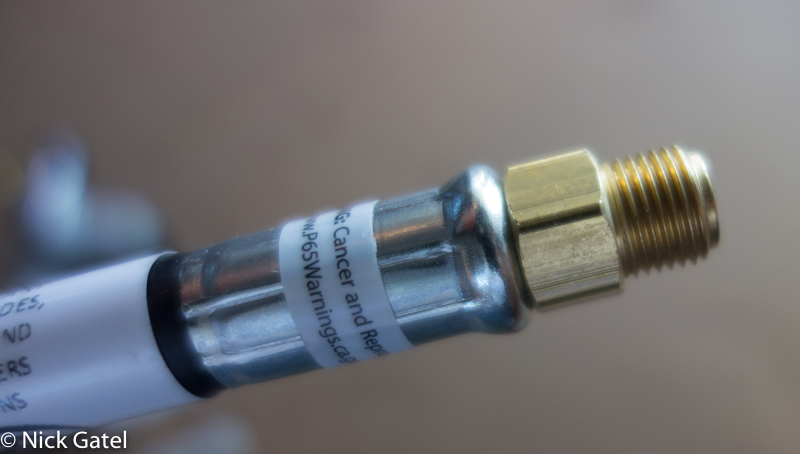
I bought a couple of Marshall Gas Controls MER425-18 propane hoses. I have always had excellent results with Marshall products.
The hoses have an overall length 18 inches (a little longer than I really needed). One end of the hose is 1/4″ Inverted Flare with Pigtail Acme Nut at the other end.
The old regulator mounting bracket I had, was one I made back in 2003, so I ordered a Marshall Excelsior MEGR-RVB Universal L-Mount Regulator Mounting Bracket, since it didn’t cost much.
Main Propane Hose — Regulator to Trailer
The last item was the propane feed hose that had become mushy and developed a kink after the criminals left. Amazon had the direct replacement, a Flame King Thermo Plastic Hose Assembly For LP and Natural Gas, 48 Inches long and , 3/8 Inch inner diameter.
The fitting female size fitting isn’t the standard size you would find at a hardware store, being a 1/2” Female Flare Swivel, whereas common hoses use a 3/8” Female Flare Swivel. The other end is the common 3/8” MNPT male thread, which is the end that screws into the pressure regulator. This is the only fitting that requires thread sealant. Make sure you don’t use the white Teflon tape or the standard plumber’s thread sealant.
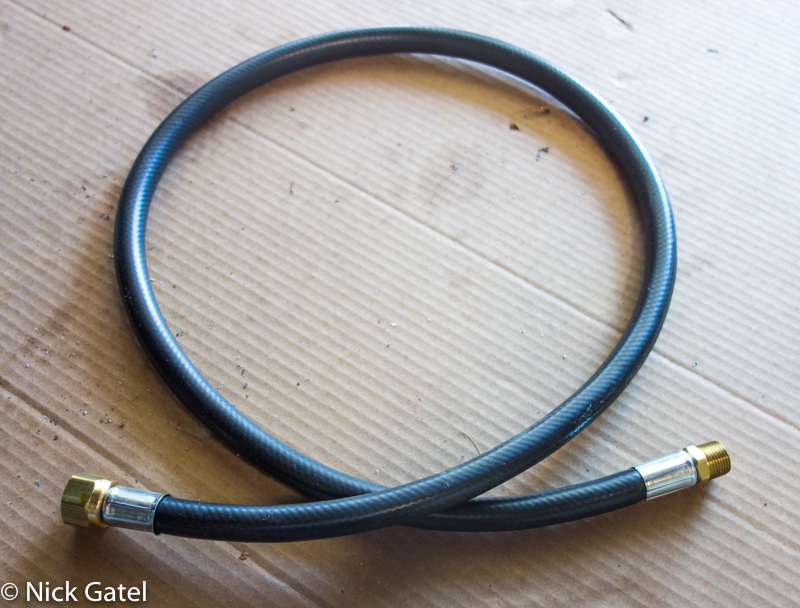
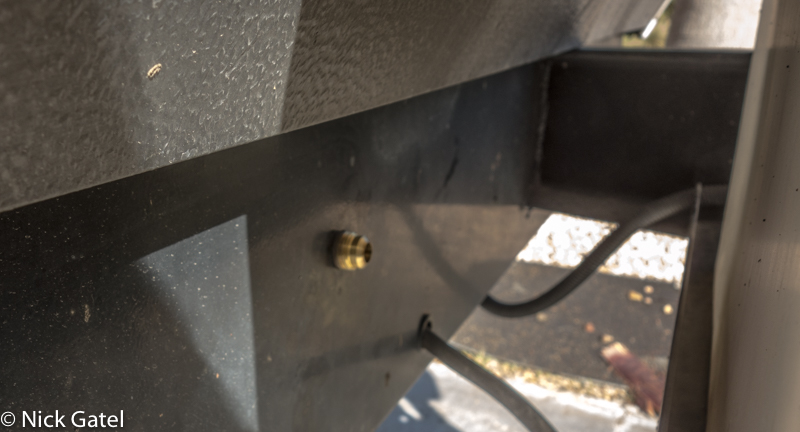
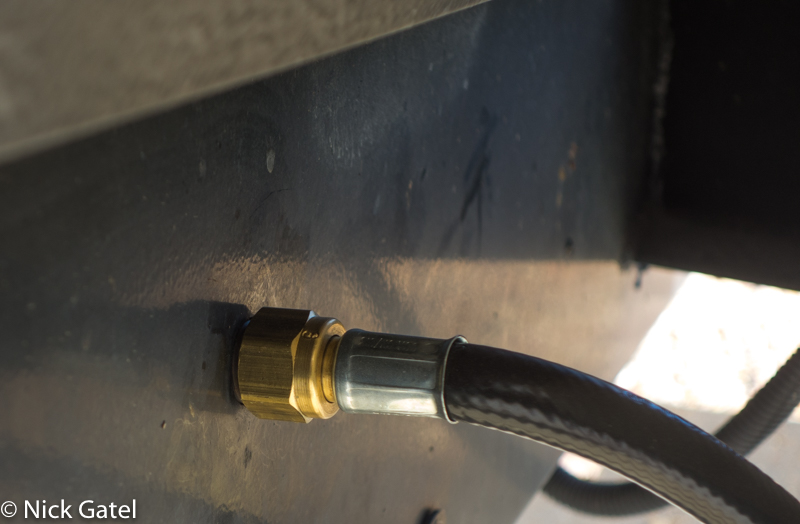
The fitting requires a sealer that is compatible with natural gas or propane, which is Yellow Teflon tape or liquid sealant.
This website may be compensated for linking to other sites for sales of products. As an Amazon Associate I earn a small fee from qualifying purchases at no additional cost to the purchaser.















